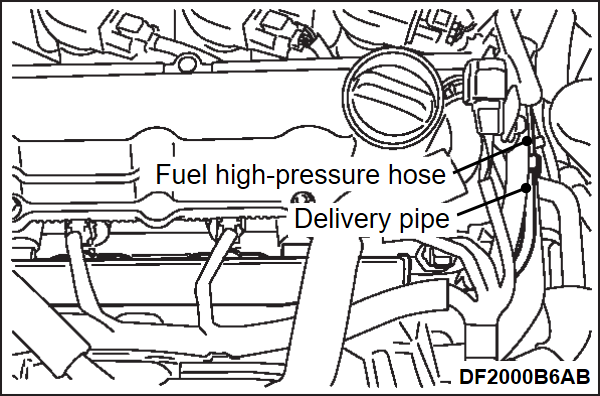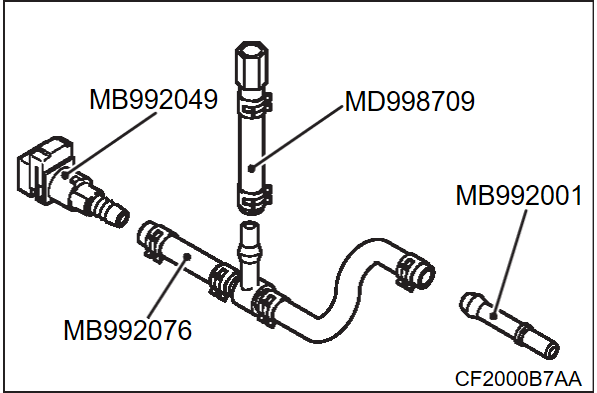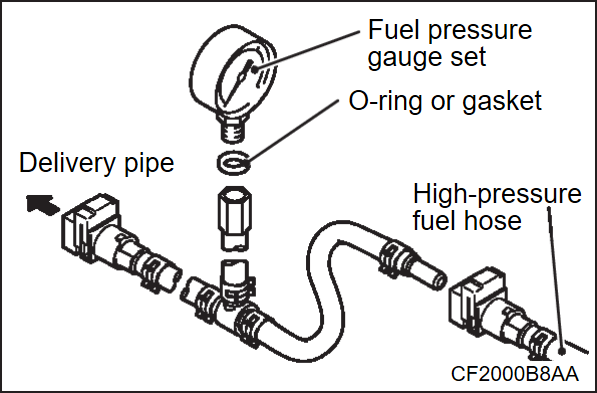FUEL PRESSURE TEST
Required Special Tools:
- MB992744: Vehicle communication interface-Lite (V.C.I.-Lite)
- MB992745: V.C.I.-Lite main harness A
- MB992747: V.C.I.-Lite USB cable short
- MB992748: V.C.I.-Lite USB cable long
- MB991981: Fuel Pressure Gauge Set
- MB992001: Hose Adapter
- MB992049: Quick Connector
- MB992076: Injector Test Set
- MD998709: Hose Adapter
1. Release residual pressure from the fuel pipe line to prevent fuel gush out (Refer to FUEL PUMP CONNECTOR DISCONNECTION (HOW TO REDUCE PRESSURIZED FUEL PRESSURE) ).
).
 ).
).| caution | Cover the hose connection with rags to prevent splash of fuel that could be caused by some residual pressure in the fuel pipe line. |
2. Remove the fuel high-pressure hose at the fuel rail.
3. Assemble the special tool called injector test set (MB992076) as shown in the figure according to the following procedure.
- Remove the injector installation adapter from the hose. Remove another hose together with the adapter and remove the adapter from the remaining hose.
- Install the special tool MB992049 (quick connector) and the special tool MB992001 (hose adaptor) to the hose without the adapter.
- Remove the nipple of the bolt of the special tool MD998709 (adapter hose).
- Install the special tool prepared in the procedure "c" to the nipple that was removed together with hose in the procedure "a".
4. Install the special tool assembled in Step 3 between the fuel rail and fuel high-pressure hose.
5. Install the fuel pressure gauge on the special tool for measuring the fuel pressure via an appropriate O-ring or gasket.
| caution | Before connecting or disconnecting the scan tool (M.U.T.-III SE), turn the power supply mode of the electric motor switch to OFF. |
6. Connect the scan tool (M.U.T.-III SE) to the data link connector.
7. Operate the electric motor switch without depressing the brake pedal and turn the power supply mode of electric motor switch to ON.
8. Select "Item No. 20" from the scan tool (M.U.T.-III SE) actuator test to drive the fuel pump. Check that there are no fuel leaks from any parts.
9. Finish the actuator test or turn the power supply mode of the electric motor switch to OFF.
10. Set the vehicle to the continuous idling mode (Refer to CONTINUOUS IDLING MODE )
)
 )
)11. Measure fuel pressure, and convert the measurement value with the formula below.
[voltage measurement value (V) - 1] × 125 kPa (18 psi)
Standard value: Approximately 324 kPa (47 psi)
12. Check to see that fuel pressure does not drop even after the engine has been raced several times.
13. If any of fuel pressure measured in steps 11 and 12 is out of specification, troubleshoot and repair according to the table below.
| Symptom | Probable cause | Remedy |
| Clogged fuel filter | Replace the fuel filter |
| Fuel leaking to return side due to poor fuel regulator valve seating or settled spring. | Replace fuel pressure regulator | |
| Low fuel pump delivery pressure | Replace fuel pump | |
| Fuel pressure is too high | Binding valve in fuel pressure regulator | Replace fuel pressure regulator |
14. Stop the engine and check change of fuel pressure gauge reading. Normal if the reading does not drop within 2 minutes. If it does, observe the rate of drop and troubleshoot and repair according to the table below.
| Symptom | Probable cause | Remedy |
| Fuel pressure drops gradually after engine is stopped | Leaky injector | Replace injector |
| Leaky fuel regulator valve seat | Replace fuel pressure regulator | |
| Fuel pressure drops sharply immediately after engine is stopped | Check valve in fuel pump is held open | Replace fuel pump |
15. Release residual pressure from the fuel pipe line
| caution | Cover the hose connection with rags to prevent splash of fuel that could be caused by some residual pressure in the fuel pipe line. |
16. Remove the fuel pressure gauge and special tool from the fuel rail.
17. Install the fuel high-pressure hose over the fuel rail.
18. Check for any fuel leaks by following the procedure in Step 7.
19. Disconnect the scan tool (M.U.T.-III SE).
![[Previous]](../../../buttons/fprev.png)
![[Next]](../../../buttons/fnext.png)


